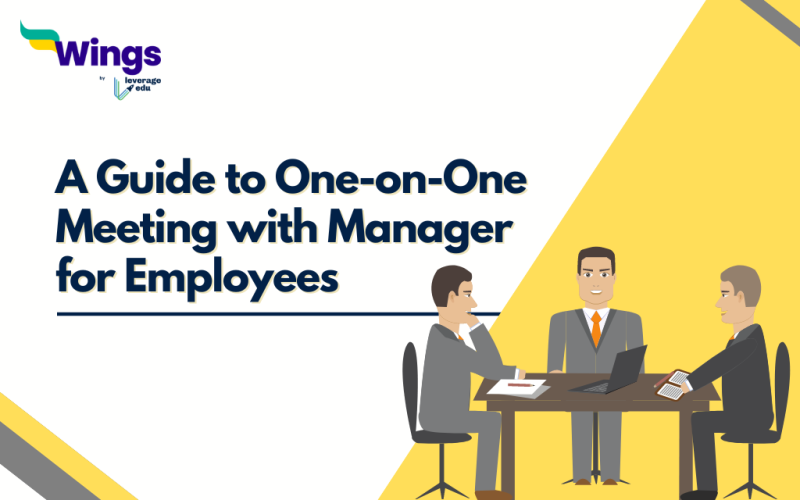A one-on-one meeting includes key elements like goal setting, a clear agenda, feedback and recognition, employee concerns, etc. It is a valuable tool for managers to engage with their team members individually, address concerns, and provide guidance. Also, this meeting helps foster a positive and productive work environment. However, employees often need clarification when a manager does schedule these meetings. To help employees address their concerns, we have created a complete guide to one-on-one meeting with manager. Continue reading to navigate one-on-one meetings like a pro.
This Blog Includes:
Also Read: Importance of Teamwork and Leadership in an Organisation
What is a One-on-One Meeting?
A one-on-one meeting, often abbreviated as 1:1 or 1-on-1, is a type of meeting where two individuals, typically a manager and an employee, or two colleagues, come together to discuss various topics in a more private and focused setting. These meetings are typically scheduled at regular intervals, such as weekly or bi-weekly, depending on the needs of the individuals involved and the nature of their working relationship.
Furthermore, these meetings are an essential part of effective communication and collaboration in the workplace.
Objectives of One-on-One Meeting
These meetings are conducted for multiple purposes, but the objectives are more or less the same. Some common objectives include:
- To provide feedback: Managers may use one-on-one meetings to provide feedback on an employee’s performance. Also, they discuss achievements, address goals, and set goals in 1:1.
- To discuss career development: Furthermore, managers can use one-on-one meetings to discuss an employee’s career aspirations. In meetings dedicated to career development, managers can provide guidance and help subordinates identify opportunities for professional growth.
- To solve problems: On top of that, when issues or challenges arise, one-on-one meetings provide a more intimate setting to discuss and address these matters.
- To get project updates: Moreover, colleagues working closely on a project might have regular one-on-one meetings to share updates, coordinate efforts, and ensure everyone is on the same page.
- To check in with the team: Besides, 1-on-1 helps build a stronger working relationship, fostering open communication and trust between individuals.
Also Read: Leadership Styles: Which Type of Leader Are You?
A Guide to One-on-One Meeting with Manager for Employees
If you are an employee in the corporate sector, here is a guide to one-on-one meeting with the manager to help you excel at this meeting. Use these tips and get the best outcome from your 1:1.
1. Recognise the Objective of the Meeting
To begin with, make sure you know why you are meeting with your boss. You should ask your manager about what you should prepare, like goals or concerns. Furthermore, acknowledge your goals using the Specific, Measurable, Achievable, Realistic, and Timely (SMART) method. You must share how your boss can support you in reaching these goals.
2. Talk About your Concerns
Furthermore, you must express any worries during the one-on-one meeting. Besides, you can offer solutions to problems and use the opportunity to agree on an action plan.
3. Be Thorough with Your Research
Moreover, be well-informed for the meeting. You must show initiative by conducting thorough, reputable research. Also, you must look at different perspectives on a topic. To reflect on your research you must prepare questions before the meeting to expand on performance or projects. You must show that you are listening to the discussion by asking follow-up questions.
4. Present Your Ideas and Reflect on What you Can Contribute to the Team
In addition, you must highlight your skills and experience that add value to the team. You should specify the tasks you want to handle and why you are the right person. Also, demonstrate a willingness to put in extra effort.
5. Be Open to Change
Moreover, you should understand that your manager might reschedule due to a busy schedule. You can politely remind them of the meeting if needed. Therefore, you should be adaptable while holding them accountable.
6. Capture Main Decisions and Action Items
It’s essential to record the key decisions and action items discussed during the meeting for accountability. Keeping meeting notes or minutes helps in tracking progress on agreed actions, ensuring that both you and your manager are on the same page regarding next steps and responsibilities. This practice not only enhances the meeting’s productivity but also serves as a reference for future discussions.
Also Read: Team Work vs Individual Work
Why is One-on-One Meeting Important for Employees?
Now that you have walked through the guide to one-on-one meeting with manager, it is time to analyze the effectiveness of 1:1’s. Here are some key advantages of a one-on-one meeting:
- Individualized attention
- Clear communication
- Feedback and recognition
- Goal alignment
- Problem-solving
- Career development
- Trust building
- Employee satisfaction
- Proactive issue resolution
- Personal connection
- Improved productivity
- Employee empowerment
Also Read: 11 Common Productivity Tools To Make Your Life Easier At Work
FAQs
Ans: It is a type of meeting where two individuals, typically a manager and an employee, or two colleagues, come together to discuss various topics in a more private and focused setting.
Ans: You can discuss about project details, career growth, future in the company, and concerns.
Ans: Here is a guide to one-on-one meeting with manager for an employee:
1. Recognise the objective of the meeting
2. Talk about your concerns
3. Be thorough with your research
4. Present your ideas and reflect on what you can contribute to the team
5. Be open to change
Related Reads
Stay in tune with Leverage Edu to explore interesting career counselling concepts.
 One app for all your study abroad needs
One app for all your study abroad needs















 60,000+ students trusted us with their dreams. Take the first step today!
60,000+ students trusted us with their dreams. Take the first step today!

